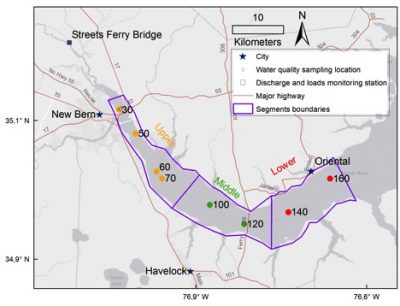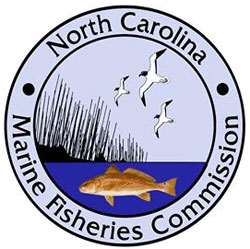
Researchers using a new forecasting tool say lower than normal levels of dissolved oxygen are likely this summer in the Neuse River estuary, creating conditions favorable for fish kills, according to North Carolina Sea Grant.
A team that includes researchers from North Carolina State University and University of North Carolina Chapel Hill has developed an experimental model to study the condition known as severe hypoxia, or oxygen deficiency, which can lead to problems that include fish kills.
Supporter Spotlight
The model shows water quality drivers in the ecosystem and has allowed researchers to forecast dissolved oxygen levels based on nutrient loads and flows over the last nine months, explained the lead researcher on the project, Daniel Obenour of N.C. State.
Through a project funded by North Carolina Sea Grant, Obenour, an environmental engineer, is collaborating with coastal ecologist Hans Paerl of the UNC Institute of Marine Sciences.
The new model builds on decades of data Paerl’s laboratory has collected through the Neuse River Estuary Modeling and Monitoring Project, known as ModMon, the release continued. That larger project has collected data along the estuarine portion of the river, between New Bern and the Pamlico Sound. The Neuse River’s headwaters, including Falls Lake, are located in the Triangle.
The model generates daily predictions of dissolved oxygen in the estuary’s bottom waters, the lowest 3 feet. While hypoxia can occur from spring through fall, July and August tend to be the most severe months for hypoxia and fish kills. Thus, predictions of July to August 2018 dissolved oxygen were aggregated to create this forecast. Average flow rates from December 2017 to April 2018 were 30 percent lower compared to mean flow rates over the two-decade study period.

Obenour and Paerl reviewed data from eight monitoring locations, which overall reflected the upper, middle and lower sections of the estuary.
Supporter Spotlight
The new model’s results suggest that a lower river-water flow rate in winter and early spring allows organic matter to build up in the estuary, instead of flushing out as usual. Because of high levels of precipitation in the spring of 2018, late spring and summer river flows are elevated by about 60 percent, compared to the mean over the past two decades. Higher flows typically carry higher nutrient loads through the estuary, which fuel algal production.
Obenour and Paerl anticipate another year of testing before their hypoxia forecasting model will be finalized. They stress that it is still experimental, even as it predicts a higher likelihood of severe hypoxia in the Neuse for July and August.
Paerl said in a statement that the experimental forecast is already beginning to be confirmed in the trend for conditions observed so far in July, and that the long-term value of the model is it will help predict the extent of hypoxia in future years.







